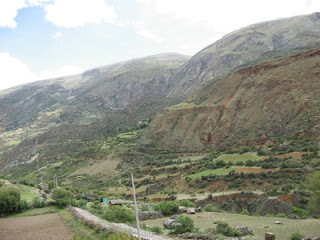I have been in Lima for about 2 and a half days, and will be leaving later tonight, in a somewhat long and protracted journey through some towns of the beaten track towards Cusco, the second biggest city in Peru. I have been staying at the
Backpackers Family House in the Miraflores suburb of Lima.
The Hostel
I have been seriously impressed with the hostel, which is run by two guys: Pedro and Christian. They have been really cool hosts, and took us (as the residents) out on the town last night and cooked a traditional Peruvian dish on Monday night. The hostel is more like a temporary digs than a hostel - it is a largish house with about 6 rooms which can take a various numbers of people. The other residents have so far been two Dutch guys, a Canadian guy, John, (who I might meet up later in Cusco), an American carpenter (who was almost like a permanent resident, but left to go back), a Canadian girl who just arrived, two Brazilians and a Columbian. John and I spent quite some time exploring Lima as we arrived on the same day, but we have made various groups to explore various areas of Lima. That is one of the really cool things I like about backpacking.
I am coming back to Lima over New Year's Day, and staying here again ... definitely the best hostel I have stayed in.
Lima
Lima is a massive city - both in its population (apparently around 7 million) and area. It is a big metropolitan area, and it reminds me a lot about South Africa (taxis) and India (bad driving, smog). It is also a very fast paced city - people are always on the move, and life seems to be fast. It is not really a beautiful city; and a friend of John apparently described it as a "big ugly city that you just have to go through". It does however have its charms.
Miraflores
Miraflores is a suburb of Lima, and is actually quite far from original city centre. It is quite an affluent area, and is full of fancy shops. Built on the cliffs overlooking the Pacific, it is also sometimes quite spectacular. And nothing is more spectacular than Larco Mar, a new shopping centre built on the cliffs, offering spectacular views. But knowing Peru's reputation of earthquakes, the rationality of this building must be raised.


Right in the middle of Miraflores, is Huach Pucllana - a pre-Inca ruin, that is being slowly restored. It is quite fascinating to see restoration in progress especially considering there are apartments overlooking the ruins.

Lima Centro
The old town, built mostly by the Spanish and thus has a lot of old European architecture.





Playing Frogger
Traffic and driving in Lima is a nightmare. Drivers it seem, only respect three parts of the traffic law: one way signs, traffic police and red lights. No other traffic signs are respected - and cars just go. Pedestrians have to play frogger to cross the road as do cars!
Taxis (the South African kind) are called Collectivos and are quite weird, and everywhere. And most passenger cars are taxi cabs (NY style) and everyone seems to use them: they are pretty cheap (no fixed rates - you have to negotiate) and thus very convenient.
Like in SA, the roads are full of street hawkers selling at road crossings and the variety is a lot more than in SA. There are also guys doing all sorts of things to earn money: doing acrobatic tricks during rush hour for example (while the lane is stopped)! No wonder that most cars have dents in them!

































